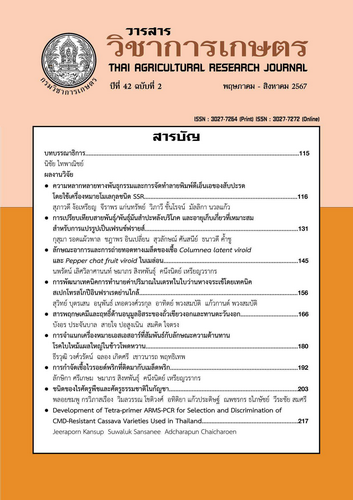ชนิดของไรศัตรูพืชและศัตรูธรรมชาติในกัญชา
DOI:
https://doi.org/10.14456/thaidoa-agres.2024.17คำสำคัญ:
ไรศัตรูพืช, ไรแดง, ไรแดงกัญชา, ไรขาว, ไรสี่ขากัญชา, ไรสนิมกัญชาบทคัดย่อ
พืชกัญชาได้รับการอนุญาตให้ปลูกเป็นพืชสมุนไพรเพื่อรักษาโรคได้ จึงเป็นพืชเศรษฐกิจใหม่ของประเทศไทย ข้อมูลทางวิชาการเกี่ยวกับชนิดศัตรูของกัญชายังมีน้อยมาก โดยเฉพาะไรศัตรูพืชซึ่งเป็นศัตรูหลักของกัญชา จึงทำการสำรวจไรศัตรูพืชและศัตรูธรรมชาติในแปลงกัญชาระหว่างเดือน ต.ค. 2564 ถึง ธ.ค. 2566 เพื่อจำแนกชนิดชื่อที่ถูกต้อง ลักษณะการทำลาย และการแพร่กระจาย ในพื้นที่ 61 อำเภอ 33 จังหวัด ในประเทศไทย พบไรและแมลงในแปลงกัญชาทั้งหมด 19 ชนิด 7 วงศ์ โดยเป็นศัตรูพืชทั้งหมด 15 ชนิด 4 วงศ์ เป็นไรตัวห้ำ 2 ชนิด 1 วงศ์ ไรกินเชื้อรา 1 ชนิด 1 วงศ์ แมลงตัวห้ำ 1 ชนิด 1 วงศ์ ผลการจำแนกไรศัตรูพืชที่พบ ได้แก่ (1) วงศ์ Eriophyidae 1 ชนิด คือ A. cannabicola (2) วงศ์ Tarsonemidae 1 ชนิด คือ P. latus (Banks) ทำให้ใบยอดกัญชา มีขนาดเล็กลง ใบหงิกงอ (3) วงศ์ Tenuipalpidae 1 ชนิด คือ B. californicus (4) วงศ์ Tetranychidae 12 ชนิด คือ E. suvipakiti Neotetranychus sp. P. elongatus T. kanzawai T. gloveri T. neocaledonicus T. piercei T. phaselus T. truncates Tetranychus sp. T. urticae และ Tetranychus hydrangeae ไรแดงในวงศ์ Tetranychidae เข้าทำลายบริเวณใต้ใบกัญชา ทำให้ใบกัญชามีสีซีด ต่อมาใบจะเหลือง และแห้ง ชนิดที่สำคัญและพบเข้าทำลายในเกือบทุกพื้นที่คือ T. truncatus ส่วนไรตัวห้ำพบ 2 ชนิด คือ A. cinctus และ N. longispinosus พบเพลี้ยไฟตัวห้ำ 1 ชนิด คือ S. asura และไรกินเชื้อราอยู่ในวงศ์ Tydeidae 1 ชนิด ข้อมูลที่ได้ในงานวิจัยนี้เป็นข้อมูลใหม่ สามารถนำไปใช้อ้างอิงและเป็นข้อมูลในการหาวิธีการป้องกันกำจัดไรศัตรูกัญชาต่อไป
เอกสารอ้างอิง
กรมการแพทย์. 2562. คำแนะนำการใช้กัญชาทางการแพทย์. กรมการแพทย์ กระทรวงสาธารณสุข. นนทบุรี. 23 หน้า.
กรมวิทยาศาสตร์ทางการแพทย์. 2563. กรมวิทย์ ฯ เพิ่มข้อกำหนดมาตรฐานผลิตภัณฑ์กัญชาในตำรายาของประเทศไทย. กรมวิทยาศาสตร์การแพทย์ กระทรวงสาธารณสุข. แหล่งข้อมูล: www3.dmsc.moph.go.th/post-view/818. สืบค้น: 13 มิถุนายน 2567.
กองบัญชาการตำรวจสันติบาล. 2565. ปลดล็อกกัญชา เช็ก ตร. แล้ว สรุปง่าย ๆ 11 ข้อ ครอบครอง-สูบ-คดี-ของกลาง. แหล่งข้อมูล https://www.bangkokbiznews.com/news/1008837. สืบค้น: 8 สิงหาคม 2565.
เมดไทย. 2563. กัญชา สรรพคุณและประโยชน์ของต้นกัญชา 30 ข้อ. แหล่งข้อมูล: https://medthai.com/กัญชา/. สืบค้น: 20 มิถุนายน 2566.
วัฒนา จารณศรี มานิตา คงชื่นสิน เทวินทร์ กุลปิยะวัฒน์ และพิเชฐ เชาวน์วัฒนวงศ์. 2544. ไรศัตรูพืชและการป้องกันกำจัด. กองกีฎและสัตววิทยา กรมวิชาการเกษตร. เขตจตุจักร กรุงเทพฯ. 192 หน้า.
สำนักงานคณะกรรมการอาหารและยา. 2562. กฎระเบียบสำนักงานคณะกรรมการอาหารและยา กองควบคุมวัตถุเสพติด. แหล่งข้อมูล: https://narcotic.fda.moph.go.th/law-type/category/rules-fda. สืบค้น: 13 มิถุนายน 2562.
Amrine, J.W.J, T.A.H. Stasny and C.H.W. Flechtmann. 2003. Revised Keys to World Genera of Eriophyoidea (Acari: Prostigmata). Indira Publishing House. Michigan, USA. 244 p.
Baker, E.W. 1975. Plant Feeding Mites of Thailand (Tetranychidae, Tenuipalpidae, and Tuckerellidae). Department of Agriculture, Ministry of Agriculture and Co-operative. Bangkok. 43 p.
Boczek, J. and K. Maciejczyk. 1993. Studies on eriophyid mites (Acari: Eriophyoidea). XIII. Bulletin of the Polish Academy of Sciences. Biological Sciences. 41(4): 405–411.
California Department of Pesticide Regulation. 2019. Legal pest management practices for cannabis growers in California, Version: October 9, 2017. Available at: https://www.cdpr.ca.gov/docs/county/cacltrs/penfltrs/penf2015/2015atch/attach1502.pdf. Accessed: September 4, 2019.
Ehara, S. and T., Wongsiri. 1975. The spider mites of Thailand (Acarina: Tetranychidae). Mushi. 48(13): 149-185.
Ehara, S. and A. Bhandhufalck. 1977. Phytoseiid mites of Thailand (Acarina: Mesostigmata). Journal of the Faculty of Education. Tottori University (Natural Science). 27(2): 43-82.
Ehara, S. 1999. Revision of the spider mite family Tetranychidae of Japan (Acari, Prostigmata). Species Diversity. 4(1): 63-141.
Flechtmann, C.H.W. 2013. A new species of Neotetranychus Traägårdh (Acari, Prostigmata, Tetranychidae) from Thailand with a key to world species. Persian Journal of Acarology, 2(1): 35-40.
Górski, R., K. Sobieralski and M. Siwulski. 2016. The effect of hemp essential oil on mortality Aulacorthum solani Kalt. and Tetranychus urticae Koch. Ecological Chemistry and Engineering S. 23(3): 505-511.
Hirsch, H. and K., Kesheimer. 2021. Russet mites in hemp. July 8, 2021. Available at: https://www.aces.edu/blog/topics/crop-production/russet-mites-in-hemp/. Accessed: March 17, 2024.
Konvipasruang, P. 2022. New record of spider mite on cannabis plant with key to the species of Tetranychus in Thailand. Entomology and Zoology Gazette. 40(2): 38-51.
Meyer, M.K.P. 1979. African Tetranychidae (Acari: Prostigmata) with Reference to the World Genera. The Republic of South Africa by the government printer, Pretoria. 175 p.
Meyer, M.K.P. 1987. The Tenuipalpidae (Acari) of Africa with Keys to the World Fauna. Republic of South Africa by the Government Printer. 135 p.
Petanovic, R., B. Magud and D. Smiljanic. 2007. The hemp russet mite Aculops cannabicola (Farkas, 1960) (Acari: Eriophyoidea) found on Cannabis sativa L. in Serbia: supplement to the description. Archives of Biological Sciences. 59(1): 81-85.
Pulkoski, M. and H. Burrack. 2020. Hemp russet mite in industrial hemp. Available at: https://Content.ces.ncsu.edu/hemp-russet-mite-in-industrial-hemp. Accessed: April 1, 2024.
Quarles, W. 2018. IPM for Cannabis pests. The IPM Practitioner Monitoring the Field of Pest Management. 36(5/6): 1-7.
Sharkey, E.R., F. Beaulieu, M.R. Moore and S.J. Bolton. 2022. Morphological and molecular data reveal the conspecificity of the spider mites Tetranychus gloveri and T. okinawanus (Acari: Trombidiformes: Tetranychidae). Systematic and Applied Acarology. 27(2): 250–268.
Villanueva, R., Z. Viloria, R. Ochoa and A. Ulsamer. 2021. Hemp russet mite, a key pest of hemp in Kentucky. Available at: https://entomology.ca.uky.edu/ef162. Accessed: April 1, 2024.
Wainwright-Evans., S. 2017. Take control of mites in Cannabis crops. Greenhouse Grower. October 22, 2017.
Xue, X.F., H. Sadeghi, X.Y. Hong and S. Sinaie. 2013. New species and records of eriophyid mites from Iran (Acari: Eriophyidae). Systematic and Applied Acarology. 18(1): 41–52.
ดาวน์โหลด
เผยแพร่แล้ว
รูปแบบการอ้างอิง
ฉบับ
ประเภทบทความ
สัญญาอนุญาต
ลิขสิทธิ์ (c) 2024 วารสารวิชาการเกษตร

อนุญาตภายใต้เงื่อนไข Creative Commons Attribution-NonCommercial-NoDerivatives 4.0 International License.
วารสารวิชาการเกษตร



